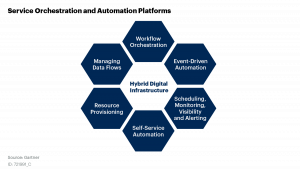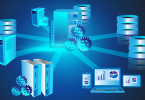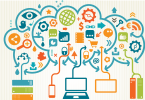SOAPs – Service Orchestration and Automation Platforms – represent the emergence of an enterprise orchestration engine that spans diverse applications and infrastructures.
As noted in Gartner’s recently published report, “Service orchestration and automation platforms (SOAPs) allow I&O leaders to design and implement business services through a combination of workflow orchestration, run book automation and resource provisioning across an organization’s hybrid digital infrastructure.”*
Our takeaway is that Gartner expects SOAPs to function as the single orchestration point for managing and executing automation tasks across the enterprise and recommends that Infrastructure and Operations (I&O) leaders invest in SOAPs to drive digital innovation and business agility.
What is driving the need for SOAPs?
Organizations continually seek to improve cost and efficiency as they scale. SOAPs hold the promise of delivering on those improvements with predictability and reliability.
Traditional job scheduling and workload automation tools have failed to keep pace with the speed and complexity of digital business. Gartner predicts that “through 2024, 80% of organizations using workload automation tools will switch to SOAPs to orchestrate cloud-based workloads.”*
While tactical IT automation met the near-term needs for reducing manual effort and its associated errors and costs, SOAPs go beyond this minimum to orchestrating much more complicated event-driven workflows both inside and outside of IT.
What are the elements of a SOAP?

As per our understanding, Gartner identifies six key capabilities of a SOAP:
- Workflow orchestration to create and manage workflows across multiple applications both on-premises and in the cloud.
- Event-driven automation to simplify IT processes involving manual steps or scripting.
- Scheduling, monitoring, visibility, and alerting to enable real-time capabilities and improve SLAs.
- Self-service automation to empower business users, developers, and others to orchestrate their own jobs.
- Resource provisioning of both on-premises and cloud-based compute, network, and storage resources.
- Managing data pipelines from automating file transfers to orchestrating the ingestion and processing of multiple data streams.
Whether available from the cloud or on-prem, SOAPs are likely to include a central administrative console, scheduling engine, workflow designer, agents for executing automation tasks, and a self-service mobile app for users. Additional capabilities may include support for machine learning algorithms and REST APIs that invoke orchestration programmatically.
What SOAPs are not
SOAPs do not necessarily replace other types of automation tools, but SOAPs that integrate with other infrastructure automation tools can amplify business benefits.
Depending on the type of automation problem they are intended to solve, diverse automation tools may co-exist in an enterprise. For example, Robotic Process Automation tools (RPAs) generally automate routine, discrete tasks that complement a business service workflow. DevOps toolchains that automate the CI/CD process may be integrated with SOAPs to automate deployment.
SOAPs may integrate with container orchestration engines, such as Kubernetes, to manage workloads deployed to containers. Whether launching containers based on a pre-defined schedule or event trigger, this integration makes it possible for SOAPs to automate workloads consistently across on-premises, private and public clouds.
What is the future for SOAPs?
The orchestration and automation of IT processes and services, and application and data workflows, are evolving and coalescing into platforms that extend the boundaries of traditional scheduling, monitoring, and service delivery tools.
As organizations modernize their I&O practices, we see that Gartner recommends I&O leaders evaluate SOAP vendors based on:
- Support for orchestrating cloud-native applications and infrastructure to prepare for cloud migration or integration with IaaS or SaaS workloads
- The depth and breadth of native integrations
- Customer support and long-term viability of the provider
“SOAPs expand the role of traditional workload automation by adapting to cloud-native infrastructure and application architecture. These tools complement and integrate with DevOps toolchains to provide customer-focused agility in addition to cost-savings, operational efficiency and process standardization.”* Find out more in the Gartner Market Guide for Service Orchestration and Automation Platforms.
* Market Guide for Service Orchestration and Automation Platforms, by Analysts Manjunath Bhat, Daniel Betts, Hassan Ennaciri, Chris Saunderson, published 17 April 2020 – ID G00721991
This graphic was published by Gartner, Inc. as part of a larger research document and should be evaluated in the context of the entire document. The Gartner document is available upon request from BMC.
Gartner does not endorse any vendor, product or service depicted in its research publications, and does not advise technology users to select only those vendors with the highest ratings or other designation. Gartner research publications consist of the opinions of Gartner’s research organization and should not be construed as statements of fact. Gartner disclaims all warranties, expressed or implied, with respect to this research, including any warranties of merchantability or fitness for a particular purpose.







